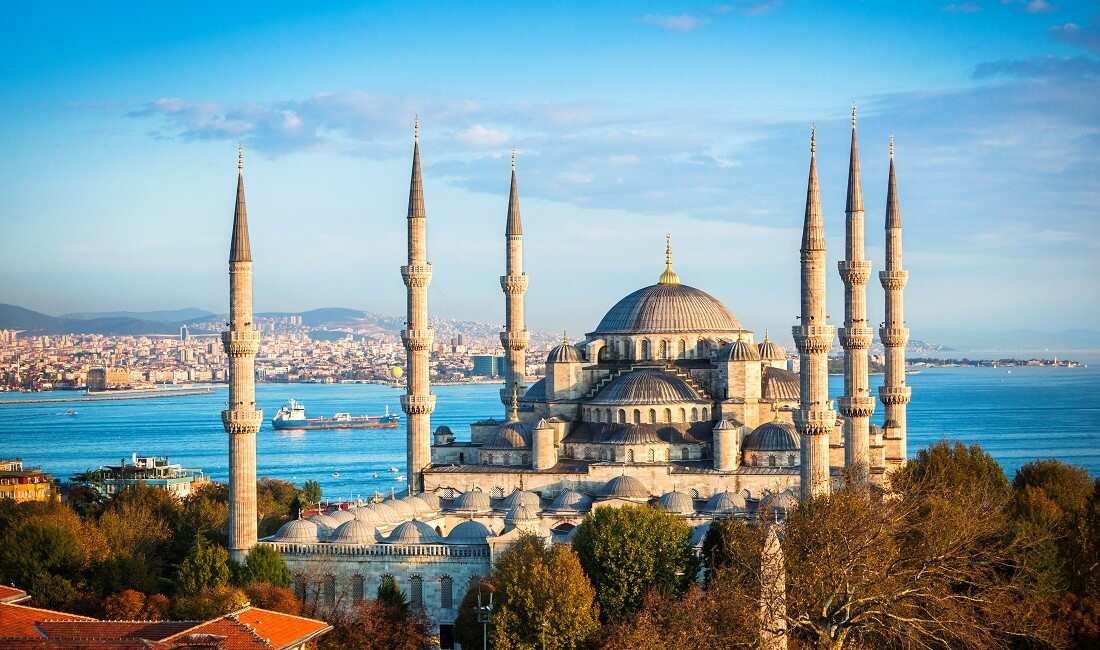
Istanbul, the vibrant and culturally rich city bridging Europe and Asia, is home to numerous architectural wonders that captivate visitors worldwide. Among these magnificent structures, the Blue Mosque, also known as the Sultan Ahmed Mosque, stands out as one of the most iconic landmarks in Istanbul. With its grandeur, elegance, and historical significance, the Blue Mosque symbolizes the city’s unique blend of history, culture, and architectural brilliance.
The Blue Mosque’s architectural design beautifully blends traditional Islamic elements with innovative features. Its most distinguishing feature is its six minarets, an unprecedented design choice at the time. The elegant domes and semi-domes that crown the mosque’s structure are adorned with intricate calligraphy and delicate geometric patterns, showcasing the artistic talent of the artisans involved.
Beyond its architectural magnificence, the Blue Mosque holds historical significance as a symbol of Ottoman power and grandeur. Sultan Ahmed I, whose vision brought the mosque to life, sought to rival the grandeur of the nearby Hagia Sophia, another iconic Istanbul landmark. The construction of the Blue Mosque was a testament to the sultan’s devotion and a statement of the Ottoman Empire’s strength and influence during its golden age.
Today, the Blue Mosque continues to serve as an active place of worship, welcoming Muslims and non-Muslims alike. It’s an open courtyard, and the hospitable atmosphere invites visitors to explore its mesmerizing beauty, learn about its rich history, and experience the tranquility of this architectural masterpiece.
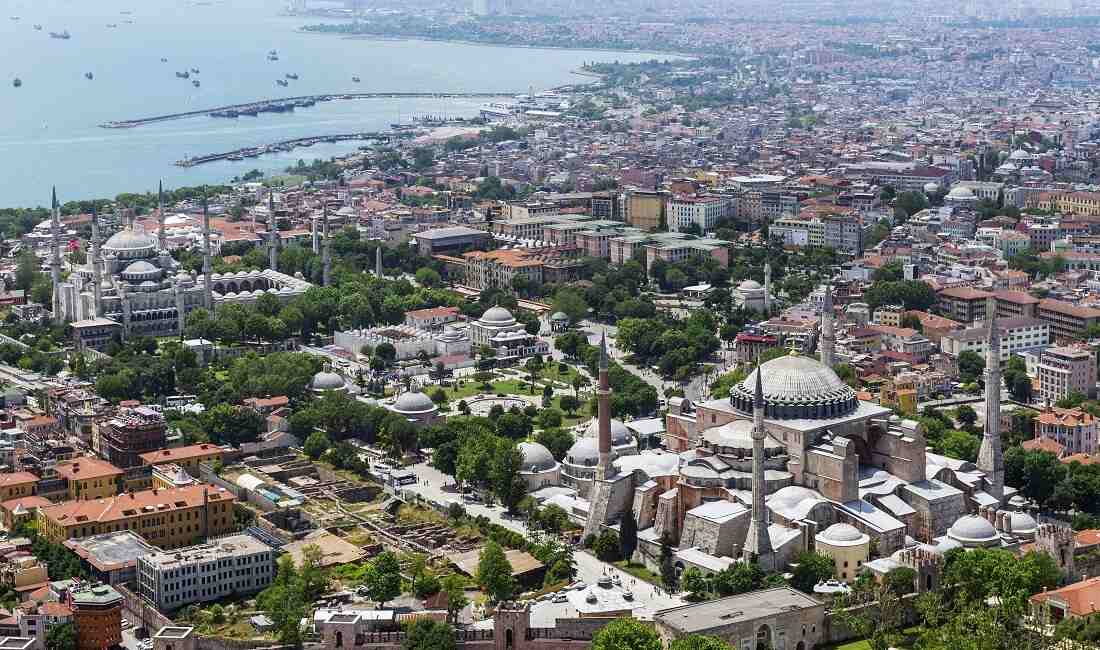
Sultan Ahmed I, who ascended to the Ottoman throne in 1603, started the construction of the Blue Mosque—inspired by his predecessors’ architectural achievements, particularly the monumental structures built during the reign of Suleiman the Magnificent, Sultan Ahmed I envisioned creating a magnificent mosque that would not only serve as a place of worship but also rival the splendor of the nearby Hagia Sophia.
In 1609, Sultan Ahmed I commissioned the talented architect Sedefkar Mehmed Agha to design and oversee the mosque’s construction. The site chosen for the mosque was located on the historical peninsula of Istanbul, close to the Byzantine Hippodrome and the Hagia Sophia. The construction process began the same year and lasted for seven years, with the mosque’s completion occurring in 1616.
Various motivations and aspirations of Sultan Ahmed I drove the construction of the Blue Mosque. One of the primary reasons was his deep religious devotion and the desire to leave a lasting legacy as a pious ruler. Building a grand mosque accommodating many worshippers reflected his commitment to Islam and his ambition to create a space for prayer and spiritual reflection.
Furthermore, Sultan Ahmed I aimed to solidify his status as a powerful ruler by undertaking ambitious architectural projects. The construction of the Blue Mosque is a testament to his authority, wealth, and ability to create enduring structures that would stand the test of time. He wanted people to remember him as a supporter of the arts and architecture, so he commissioned this magnificent mosque as a permanent landmark in the Istanbul skyline.
The construction of the Blue Mosque took place during the zenith of the Ottoman Empire, often referred to as the “Golden Age” of the empire. At this time, the Ottomans had expanded their influence and controlled vast territories spanning three continents. The realm was characterized by cultural, intellectual, and artistic flourishing, with Istanbul as its vibrant capital.
The Blue Mosque emerged within this historical context as a significant symbol of Ottoman power, luxury, and religious devotion. It embodied the empire’s architectural prowess and ability to fuse different artistic influences into a unique, awe-inspiring structure. The mosque’s construction reflected the imperial ambitions of the Ottoman rulers, who sought to leave a lasting legacy through monumental architectural projects.
Moreover, the Blue Mosque reflected the Ottoman Empire’s tolerance and religious pluralism. Despite being a mosque, it welcomes Muslims and non-Muslims. The Sultan Ahmed Mosque is a testament to the empire’s ability to create spaces that accommodate different communities, fostering a sense of unity and inclusivity within its diverse population.
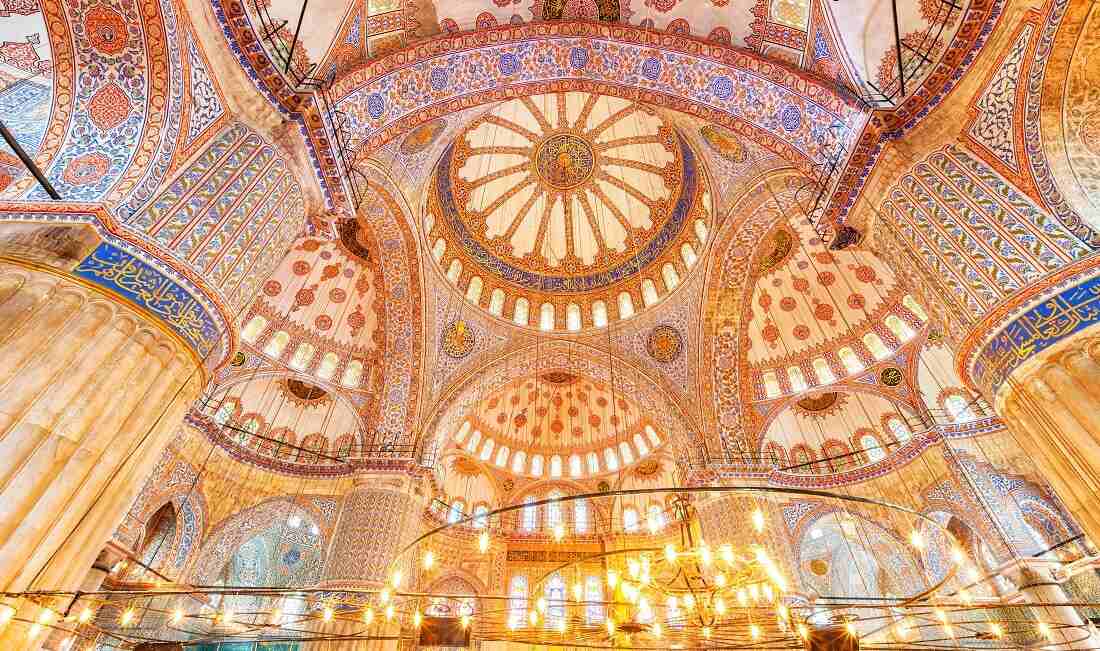
The Blue Mosque exemplifies a unique architectural style that combines Ottoman and Byzantine design elements. The influence of the Byzantine architectural tradition is evident in the mosque’s layout and certain decorative features. In contrast, the Ottoman architectural style adds distinct characteristics, resulting in a harmonious fusion of the two.
The central dome of the Blue Mosque is reminiscent of Byzantine architecture, explicitly drawing inspiration from the grand dome of the nearby Hagia Sophia. This enormous dome has a striking profile because smaller domes on either side support it. The use of crowns is a hallmark of Byzantine architecture, symbolizing the celestial realm and conveying a sense of magnificence and spirituality.
In contrast, the mosque’s exterior showcases Ottoman architectural elements, characterized by its elegant minarets, cascading domes, and central courtyards. The Ottoman minarets, six in total, are slender and towering, embellished with balconies and balconettes. These minarets, along with the mosque’s imposing façade, contribute to its grandeur and serve as a visual representation of the Ottoman Empire’s power and influence.
The Blue Mosque follows a traditional mosque layout with a central domed prayer hall surrounded by courtyards and ancillary structures. The spacious prayer hall occupies the heart of the mosque, providing ample space for worshippers. The central dome, which spans an impressive diameter, is supported by semi-domes and arches, creating a harmonious and balanced interior space.
As previously mentioned, the mosque’s six minarets are a distinctive feature. It is worth noting that having six minarets was considered a bold design choice at the time, as it was unprecedented. The minarets are strategically positioned around the mosque, accentuating its grandeur and offering a sense of symmetry. They also serve a functional purpose, allowing the call to prayer (adhan) to be proclaimed from their balconies.
Surrounding the central prayer hall, the Blue Mosque encompasses spacious courtyards, which provide a tranquil and inviting ambiance. The yards feature elegant arcades, domed pavilions, and fountains, creating an atmosphere of serenity and reflection. These courtyards serve as gathering spaces, facilitating social interactions and fostering community among worshippers and visitors.
One of the most fascinating aspects of the Blue Mosque is its exquisite tile work, which adorns both the interior and exterior surfaces. The mosque’s vibrant blue and white tiles give it its famous name and contribute to its distinct appearance.
Blue Iznik tiles in various geometric patterns, floral motifs, and calligraphic inscriptions decorate the interior of the Blue Mosque. Skilled artisans, who labored over each one until it was perfect, made these tiles. The blue color symbolizes the heavenly realm and evokes a sense of spirituality, creating a serene and meditative atmosphere within the mosque.
The calligraphic inscriptions, elegantly integrated into the tile work, feature verses from the Qur’an and poetic expressions of praise to Allah and the Prophet Muhammad. The delicate calligraphy, executed in the traditional Ottoman script, enhances the visual appeal of the mosque while serving as a reminder of its sacred purpose.
Beyond the interior, the exterior façade of the Blue Mosque also showcases intricate tile work, embellishing the domes, minarets, and entrance portals. The tiles depict intricate floral patterns, geometric motifs, and Quranic verses, contributing to the mosque’s cohesive design and harmonious aesthetic.
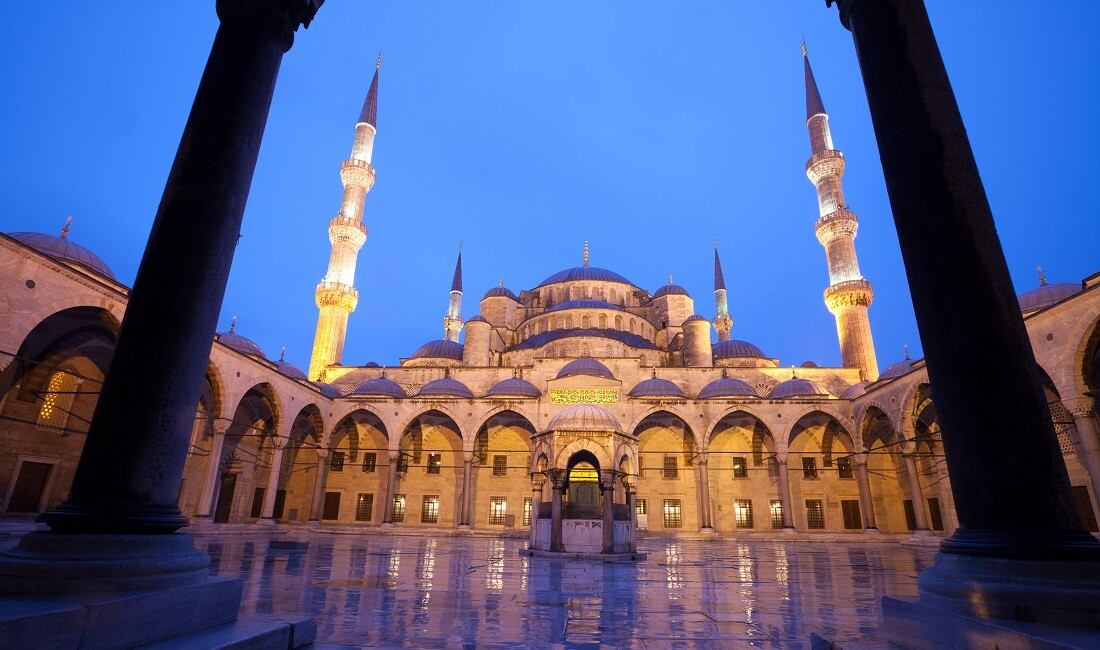
1. The Grand Interior of the Blue Mosque
Upon entering the building, Blue Mosque will dazzle visitors with its serene and majestic interior. The vast space of the prayer hall, with its soaring domes and expansive arches, creates a sense of awe and reverence. The interior design accommodates many worshippers while maintaining a feeling of openness and spaciousness.
The Spacious Prayer Hall
The prayer hall of the Blue Mosque is a sight to behold. It is adorned with a myriad of intricate details and exquisite decorations. Magnificent chandeliers are suspended from the high ceilings, illuminating the space with a gentle glow. These chandeliers are not just functional lighting fixtures but also beautiful decorative pieces.
Stained glass windows add beauty and spirituality to the prayer hall by diffusing natural light and generating a hypnotic interplay of colors. The interplay of light and shadow, combined with the intricate tile work, adds depth and richness to the interior atmosphere.
Ornate decorations adorn the prayer hall’s walls, arches, and columns. Elaborate plasterwork featuring intricate geometric patterns and floral motifs embellishes the surfaces, adding a sense of refinement and elegance. These artistic pieces, created by experienced artisans, exhibit the care and skill that went into designing and building the Blue Mosque’s interior.
2. Essential Elements within the Mosque
The Blue Mosque houses several essential elements that hold significant religious and cultural significance. One of these elements is the mihrab, a semicircular niche in the wall of the prayer hall, indicating the direction of Mecca. The mihrab is intricately decorated with calligraphy and geometric designs, drawing attention to the focal point of prayer.
Adjacent to the mihrab is the minbar, a raised pulpit from which the imam delivers sermons during Friday prayers. The minbar is typically crafted with ornate woodwork and may be adorned with intricate carvings and inlaid designs. It serves as a symbol of authority and leadership within the mosque.
The Blue Mosque also features an exquisite collection of Ottoman-era carpets covering the prayer hall’s floors. These carpets are woven with beautiful patterns and bright colors to create a peaceful environment for worshipers to kneel on.
Additionally, the mosque includes ablution fountains, or sadirvan, located in the courtyards, providing a place for ritual washing before prayer. These fountains are adorned with decorative elements and often feature marble carvings or tiles, contributing to the overall aesthetic beauty of the mosque.
In summary, the interior of the Blue Mosque is a harmonious blend of grandeur, intricate decorations, and significant religious elements. The spacious prayer hall, adorned with chandeliers, stained glass windows, and ornate details, creates an ambiance of awe and tranquility. The mosque’s mihrab, minbar, and other elements add to its religious and cultural significance. These interior features make the Blue Mosque a place of spiritual contemplation and architectural splendor.
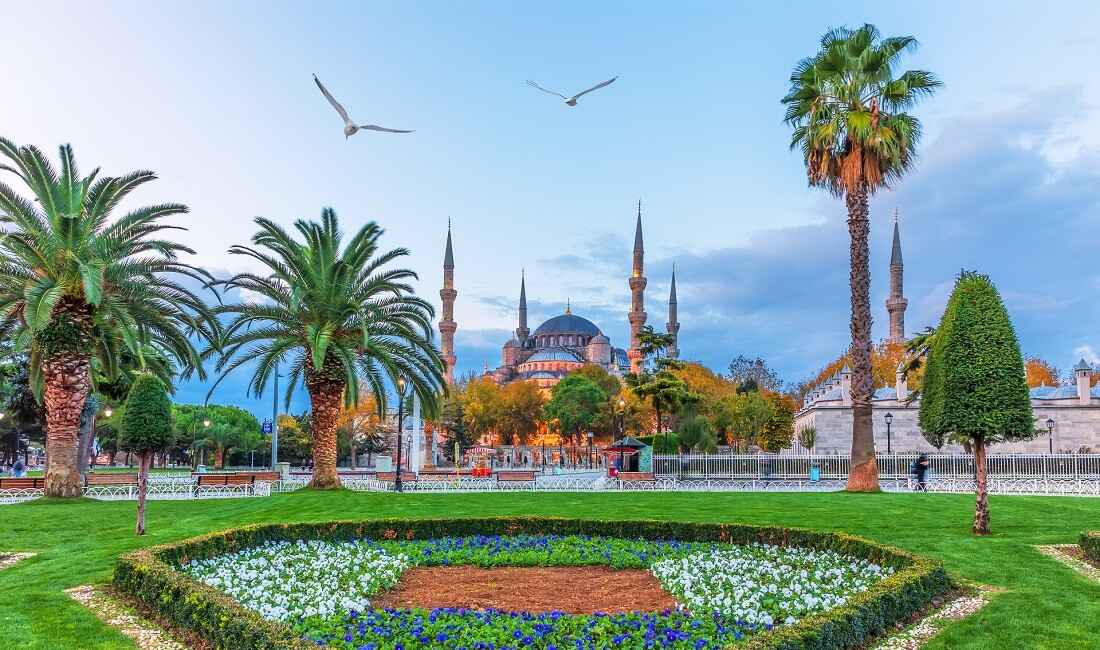
The Blue Mosque is a sacred site for Muslims and is still used regularly for worship. It is a space where the faithful come together to engage in the daily rituals of prayer, reflection, and spiritual connection. The mosque provides a sacred environment fostering deep devotion and reverence among worshippers.
The regular call to prayer echoes from the minarets of the Blue Mosque, inviting Muslims to gather for the five daily prayers. The spacious prayer hall accommodates a large congregation, allowing worshippers to unite and be devoted. The mosque provides an atmosphere conducive to spiritual contemplation, helping individuals connect with their faith and find solace in their prayers.
The Blue Mosque plays a vital role in the daily lives of Muslims, particularly those residing in Istanbul. It serves as a hub of religious and social activities, providing a sense of community and belonging. Beyond the prescribed prayers, the mosque hosts various religious gatherings, educational programs, and community events that enrich the lives of Muslims and promote a strong sense of communal harmony.
Muslims visit the Blue Mosque not only for prayers but also to seek spiritual guidance, offer supplications, and find solace in tranquil surroundings. The mosque acts as a sanctuary where individuals can find peace, connect with fellow believers, and engage in acts of charity and kindness. It serves as a reminder of the importance of faith and encourages individuals to lead virtuous lives.
Moreover, the Blue Mosque is not limited to the local Muslim community. It welcomes visitors from around the world, allowing them to experience the beauty of Islamic architecture, witness the devotion of worshippers, and gain a deeper understanding of Islam. The mosque bridges different cultures and faiths, promoting dialogue, compassion, and mutual respect.
The Blue Mosque is known for its vibrant cultural traditions and events that enhance its significance. Taraweeh prayers, during which the entire Quran is recited, are held nightly in the mosque during the holy month of Ramadan. The mosque comes alive with worshippers who gather for these special prayers, creating an atmosphere of devotion and spirituality.
The Blue Mosque is often a venue for religious festivals and celebrations, such as Eid al-Fitr and Eid al-Adha. These occasions bring together Muslims from near and far to commemorate and express gratitude for spiritual milestones, fostering a sense of community and joy.
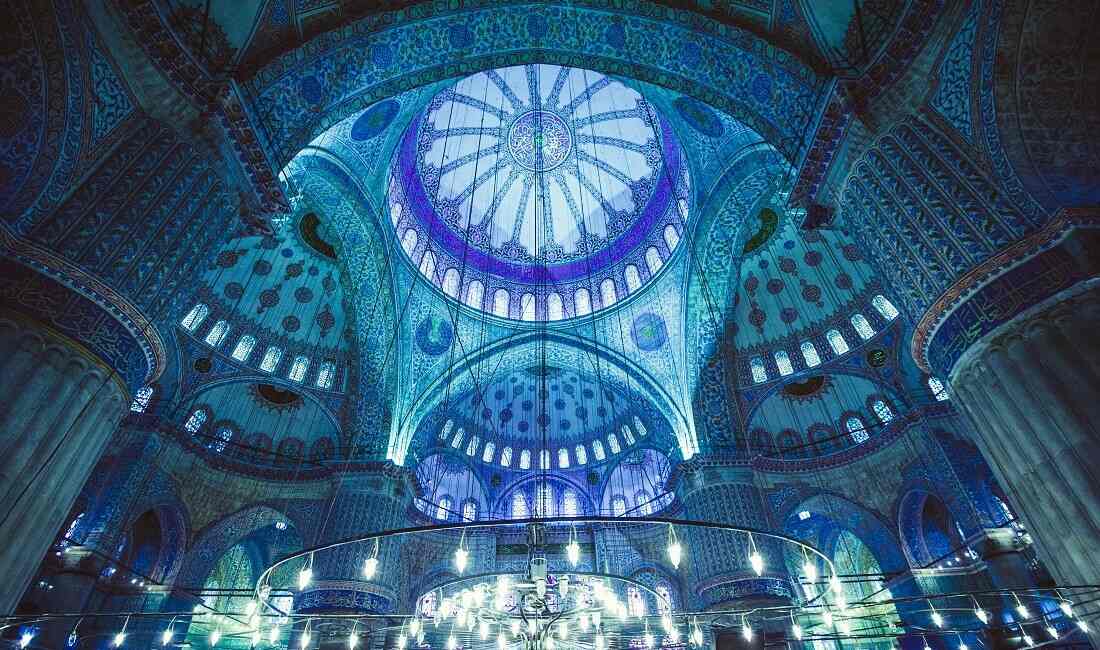
1. Practical Information for Visitors
The Blue Mosque welcomes visitors from around the world, allowing them to experience its architectural splendor and cultural significance. Visitors must be aware of certain practical information before planning their visit. The mosque’s opening hours typically coincide with prayer times, so checking the schedule in advance is recommended to ensure it aligns with your visit.
If you plan on visiting the Blue Mosque, dress appropriately. A sense of respect suitable for a house of worship is necessary. Covering your belly, shoulders, and knees is a must for both sexes. Women should cover their hair and heads with scarves. Visitors who don’t feel comfortable in their modest apparel might borrow clothing from the mosque.
2. The Experience of Visiting the Blue Mosque
The exterior of the Blue Mosque is stunning, with soaring domes and graceful minarets that immediately impress visitors. Before entering the mosque, removing your shoes and placing them in the designated shoe storage area is customary. It is advisable to carry a plastic bag to keep your boots in and ensure their safekeeping.
Visitors enter the mosque and find themselves in a serene and peaceful atmosphere. The spacious prayer hall, with its magnificent architecture and intricate decorations, offers a sense of awe and tranquility. Visitors can take their time to admire the beautiful tile work, calligraphy, and ornate details that adorn the interior.
It is essential to be respectful during the visit, maintaining a quiet demeanor and refraining from disruptive behavior. Visitors should avoid walking in front of those engaged in prayer and not touch any religious objects or artifacts.
The Blue Mosque holds immense historical and cultural value, so significant efforts have been made to preserve and maintain its architectural integrity. The responsible authorities, in collaboration with conservation experts, have implemented various measures to ensure the longevity of the mosque.
Regular inspections and assessments are conducted to monitor the structural stability and identify any signs of deterioration. These inspections include watching the domes, minarets, walls, and decorative elements for cracks, water damage, or other forms of wear and tear. Swift actions are taken to address any issues and prevent further damage.
Additionally, the mosque is subject to regular cleaning and maintenance. The intricate tile work, calligraphy, and plaster decorations require delicate care to prevent the accumulation of dust and dirt and preserve vibrant colors and intricate details. Skilled artisans carry out these tasks with utmost precision and care.
Over the years, several restoration and conservation projects have taken place to safeguard the Blue Mosque and restore its original splendor. Teams of architects, art historians, and craftspeople, who focus on historic preservation, usually work together to complete these projects.
Restoration efforts have focused on various aspects of the mosque, such as repairing damaged tiles, consolidating structural elements, and restoring decorative elements. These projects aim to recreate the original beauty of the mosque while adhering to the principles of historical accuracy.
One notable restoration project occurred in the late 20th century when the mosque underwent comprehensive conservation work. This restoration involved cleaning and restoring the interior and exterior surfaces, repairing damaged sections, and reinforcing the structural elements. The project ensured preserving the mosque’s architectural integrity and cultural significance.
Preserving a significant and historic structure like the Blue Mosque poses several challenges. One of the primary challenges is the natural aging and deterioration of the materials used in the construction. Exposure to the elements can cause slow decay and damage due to variables like moisture, pollution, and temperature fluctuations.
Another challenge is striking a balance between preservation and the demands of modern usage. The Blue Mosque continues to be an active place of worship, accommodating many visitors daily. Balancing the need for conservation with the practical requirements of an operational mosque can be complex, as certain modifications may be necessary to ensure the safety and comfort of worshippers.
Financial constraints can also present challenges in the preservation of historic structures. The costs associated with maintenance, restoration, and ongoing conservation efforts can be significant. Securing adequate funding for these projects is crucial to ensure the long-term preservation of the mosque.
Lastly, managing the increasing number of visitors while ensuring the protection of the mosque can be a challenge. Visitor guidelines, crowd management strategies, and educational programs can minimize the impact of tourism on the structure while promoting responsible visitation.

The Blue Mosque is an enduring symbol of Istanbul’s rich history and cultural heritage. Its construction and founding during the reign of Sultan Ahmed I highlight its historical importance within the Ottoman Empire. The Blue Mosque, one of the city’s most famous structures, symbolizes Istanbul’s rich history and is a point of pride for its residents and visitors.
The Blue Mosque’s architectural beauty is a marvel to behold. Its unique blend of Ottoman and Byzantine elements creates a visual masterpiece that captivates all who look at it. The grandeur of the interior, with its spacious prayer hall, intricate tilework, and ornate decorations, evokes a sense of awe and tranquility. The spiritual atmosphere within the mosque envelops visitors, inviting them to experience a moment of reflection and connect with the divine.
A visit is highly recommended to appreciate the Blue Mosque’s grandeur and cultural heritage truly. Stepping foot inside the mosque allows one to witness firsthand the architectural splendor and sense of spirituality that permeates the space. From the intricate tile work and calligraphy to the majestic domes and minarets, every detail tells a story of the mosque’s significance.
Whether you want to see the Blue Mosque for its historical value, beautiful architecture, or spiritual atmosphere, you will have a memorable time there. It is an opportunity to immerse yourself in the rich culture and heritage of Istanbul, to witness the devotion of worshippers, and to marvel at the timeless beauty of Islamic architecture.
As you explore the bustling streets of Istanbul, make sure to set aside time to visit the Blue Mosque. Allow its grandeur to leave a lasting impression on your heart and soul as you connect with centuries of history and spirituality. The Blue Mosque awaits, ready to embrace you with its architectural splendor and cultural significance.
